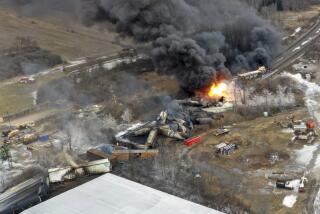Delay Decision on Nuclear Missile Shield
- Share via
A state-of-the-art, successful national missile defense program, which could insulate America from nuclear, chemical or biological attack, is too important to rush a decision on its deployment. Instead of deciding its fate this June, as the president is scheduled to do, the decision should be deferred to the next administration.
The post-Cold War version of our national missile defense shield is a limited, scaled-down approach with a different mission from its “Star Wars” predecessor. When fully deployed, the current shield’s 200 interceptors will be positioned only to protect the United States, not our allies or our troops abroad. Also, the shield only could handle a limited attack of fewer than 50 ballistic missiles at a time--relatively useless if we were to face an all-out attack from Russia, China or some future nuclear powerhouse.
The new missile shield was designed to guard us against our newest and perhaps greatest military threat: rogue nations and international terrorists with little to lose. If these enemies were to launch a nuclear, chemical or biological attack against the United States, it would be to make a statement by killing millions of Americans. With a massive U.S. counterattack a certainty, these opponents would not be deterred unless our shield was so effective that their initial attack would be an act of futility. Unlike the 1980s, when just the threat of a workable Star Wars helped us win the Cold War, today’s shield must have a reputation of 100% effectiveness.
Unfortunately, during these early stages of development, the shield has failed two of its first three tests. If the shield fails, we will never get a second chance to defend our people. But we do have a first chance, and that is to deny these terrorists and rogue nations--including Iraq, Iran and North Korea--the ability to develop and deploy nuclear, chemical and biological weapons. So we must continue our investment in nonproliferation programs such as cooperative threat reduction and the nuclear cities initiative to shut down the availability of nuclear, chemical and biological materials in the international black market.
The risk we take in deploying the shield now is that Russia would misread this defensive measure as a signal that the United States is weakening its commitment to nonproliferation. Under this view, the shield would be seen as a tactical edge that would make the United States more likely to launch a first strike, knowing that it could defend against a measured response. The Senate’s refusal to pass the Comprehensive Test Ban Treaty and the anti-American tones permeating Russian Duma elections this year make such an interpretation likely in the short term.
Our success in gaining Russia’s acceptance of the shield is critical for two reasons. First, before we could deploy the shield, we would have to renounce the 1972 Antiballistic Missile Treaty, which prohibits such a defense system, or secure Russia’s agreement to amend the treaty. Second and more important, we cannot afford for Russia to abandon negotiations to reduce both their and our nuclear stockpiles through the START treaties or our joint efforts to lock down Russia’s nuclear weapons and material. If that happens, an uncontrollable arms race could result, characterized by small, unstable players that would gain in stature by leveraging their newly acquired nuclear capability.
The shield can be a significant new arrow in the quiver of a comprehensive national defense strategy. It could be our best insurance plan against a ballistic threat that a congressionally mandated report in 1998 called “broader, more mature and [rapidly] evolving.” An ineffective and poorly handled missile defense shield, however, would defeat its own purpose, be a terrible waste of U.S. taxpayer dollars and halt the continued research and development needed to cure it.
If we are to successfully navigate the changing threats of the post-Cold War world, we must provide the American people with a defense against nuclear, chemical or biological attacks. The shield already is showing promise, and it is an initiative worth pursuing with vigor. But before spending $12.7 billion to deploy it, we must be assured that it is technologically and diplomatically sound. That is a judgment call that the next administration will be in a better position to make.
More to Read
Sign up for Essential California
The most important California stories and recommendations in your inbox every morning.
You may occasionally receive promotional content from the Los Angeles Times.













